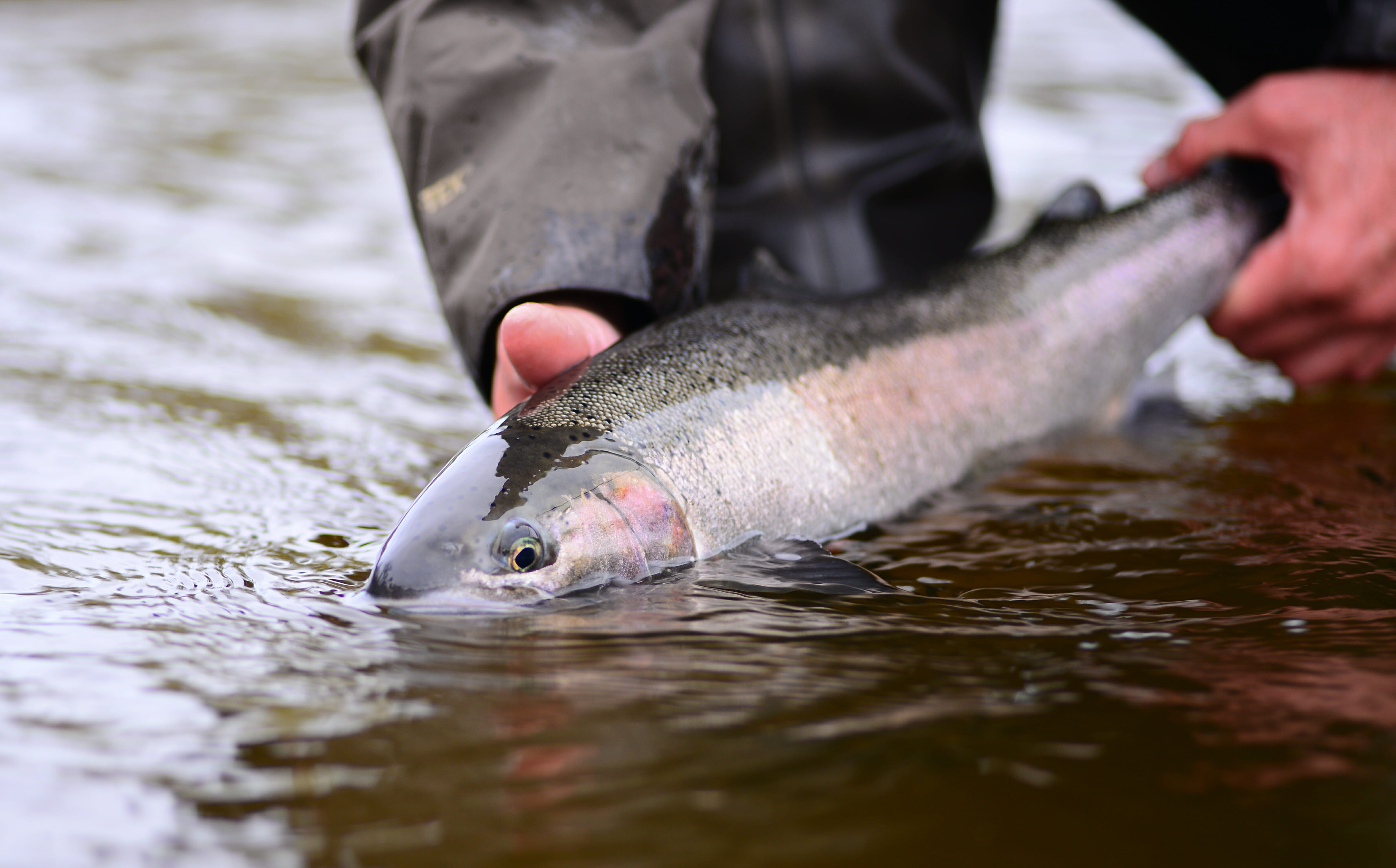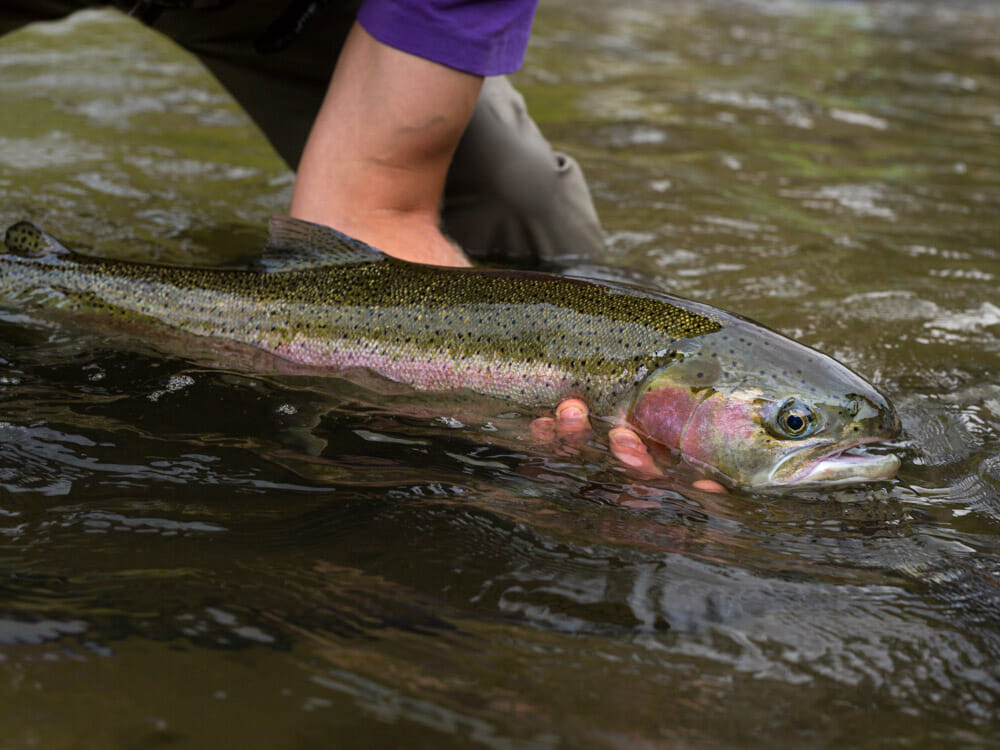Editors note: Every Friday, our science junkies over at Trout Unlimited’s Wild Steelhead Initiative give us an inside look at what’s happening in the world of steelhead science. During the Holidays, we’re running the best of those Science Friday pieces on the TU blog. If you’ve ever spent any time thinking about the sheer game of chance involved in the life-cycle of a wild steelhead, you know this is a world filled with drama, wonder, and downright crazy stuff. And at TU no one knows it better than our science experts. Here are a few of our favorite posts from 2017.
Want more? Follow along at wildsteelheaders.org.
By John McMillan
Originally published October 2017
Most steelhead anglers know that the family of fishes called salmonidae (trout, char, salmon and whitefish) are highly sensitive to water temperature and quality. These fishes require cold, clean water to thrive. But what happens to them when water temps become unfavorable? As you might expect, they seek out places in the river that regain cool water — now often referred to as thermal refuges.
Steelhead are ectotherms, meaning their body temperature is controlled by their immediate environment. If conditions become too warm or cold for them, they must seek out a different location with more suitable temperature. This activity is known as behavioral thermoregulation.
A 2009 paper highlighted the importance of these areas with a healthy temperature range for returning steelhead, and discussed some important reasons why steelhead may need additional protection in some of these areas.
 src=”http://www.tu.org/wp-content/uploads/2018/12/DSC_9049.jpg” />In the Columbia River system, it turns out that steelhead utilize cold water refuges in the Columbia mainstem more than salmon. Steelhead take a long time to make it to their spawning areas in this watershed and thus are better able to wait out periods of elevated water temps. The 2009 study found that Columbia River steelhead had much longer residence times in cold water plumes than did salmon migrating at the same time — in fact, steelhead sometimes spend months in one small area of the river.
src=”http://www.tu.org/wp-content/uploads/2018/12/DSC_9049.jpg” />In the Columbia River system, it turns out that steelhead utilize cold water refuges in the Columbia mainstem more than salmon. Steelhead take a long time to make it to their spawning areas in this watershed and thus are better able to wait out periods of elevated water temps. The 2009 study found that Columbia River steelhead had much longer residence times in cold water plumes than did salmon migrating at the same time — in fact, steelhead sometimes spend months in one small area of the river.
This study also found that at temperatures below 19°C (66°F) it took an average of 3 days for steelhead to migrate from Bonneville to The Dalles dam. As temperatures climbed the migration rate rapidly declined. At water temps above 21°C (70°F) it took an average of 25 days for steelhead to cover the same distance; many fish were holding in cold water areas between the dams. The study authors also noted that below 19°C only about 10% of the steelhead run were using cold refuges, but at temperatures of 21°C and above more than 70% of the run were using refuges at any given time.
While these discrete areas of cold water provide refuge from the negative impacts of warm water, they also expose fish to other impacts such as increased harvest. Anglers have long known that steelhead aggregate in specific areas of the river each year. The authors of the study found that steelhead using these areas were 8% less likely to complete their migration successfully. This effect was about twice as high for hatchery fish as it was for wild steelhead (5% vs 11%). This is most likely due to the intensive angling, and associated harvest, that often takes place in and adjacent to thermal refuges.
Steelhead anglers are well aware of the benefits cold water refuges offer to fish and fishermen.
Many fish that were initially tagged were unaccounted for later in the study, which is to be expected as fish stray and are harvested during their migration. Interestingly, a greater percentage of fish that disappeared from the mainstem, i.e. were not recorded moving into tributaries or as harvested, were fish that had been documented as using cold water refuges. A likely reason for this is that these fish were caught and harvested near cold water refuges but not recorded during sampling, so the effect may have been more significant than noted in the study. The authors also noted it was possible that fish in poor condition seek out cold water refuges and that many of these fish die of natural causes, thereby increasing the observed mortality rate. While this seems unlikely to have been significant enough to produce the observed results, it could have contributed. Regardless, we know many fish are using these areas and when that is combined with intense angling pressure it translates to high encounter rates.
Not all steelhead that return to the Columbia use these refuges equally. The earliest returning fish typically migrate quickly through the mainstem into upriver areas where they find suitable holding habitat. They are not dependent on these lower Columbia refuge areas because the mainstem has not warmed significantly by their time of entry. Similarly, steelhead that enter the Columbia in September and October do not use these as extensively because temperatures in the mainstem have generally cooled by that time. The fish that enter in mid-summer spend the most time in these areas and are the most dependent on them for survival.
The Columbia historically had a strongly bimodal return of steelhead, more commonly known as A and B runs. It is possible this run timing evolved due to the better conditions for migrating in early summer and fall during cool water periods. Over the past few decades these two runs have become less defined with a greater proportion of fish entering the river in midsummer (Robards 2002). While there is some uncertainty as to why the run timings have changed, the bottom line is that more fish are entering freshwater during the heat of summer. This is important because peak cold water refuge use by steelhead was highly correlated with mainstem temperatures during the study.
The principal take-away here is that thermal refuges are vitally important for migrating steelhead, and we should do everything we can to protect the habitat qualities of these areas. And at times of extreme atmospheric heat (with corresponding dangerously high water temps) we must strongly consider “hoot owl” fishing closures and other self-imposed restraints on angling until conditions become less stressful for our beloved O. mykiss.
 Trout Unlimited’s Wild Steelhead Initiative and associated advocacy group, Wild Steelheaders United is an ambitious and hopeful effort to protect and restore wild steelhead. Today, 70 percent of the major steelhead populations in Oregon, Idaho, Washington and California require federal protection and opportunities to catch wild steelhead have diminished dramatically in many rivers. For more information, go to wildsteelheaders.org or join us on Facebook and Instagram.
Trout Unlimited’s Wild Steelhead Initiative and associated advocacy group, Wild Steelheaders United is an ambitious and hopeful effort to protect and restore wild steelhead. Today, 70 percent of the major steelhead populations in Oregon, Idaho, Washington and California require federal protection and opportunities to catch wild steelhead have diminished dramatically in many rivers. For more information, go to wildsteelheaders.org or join us on Facebook and Instagram.



